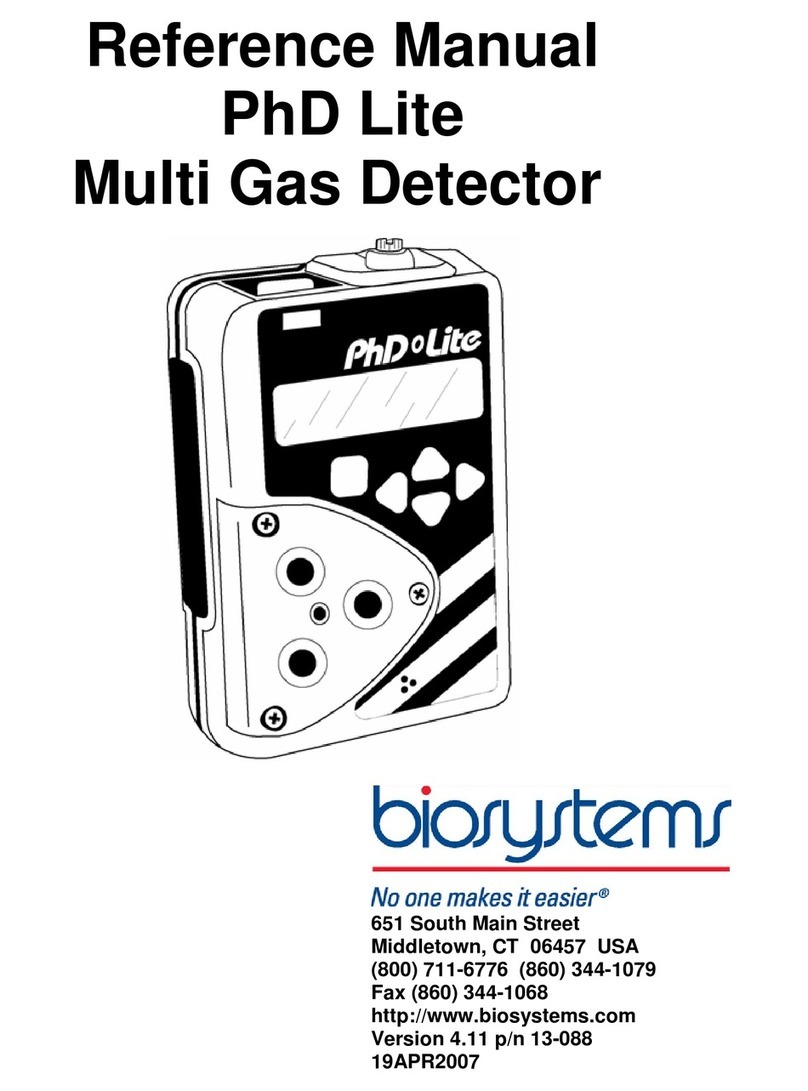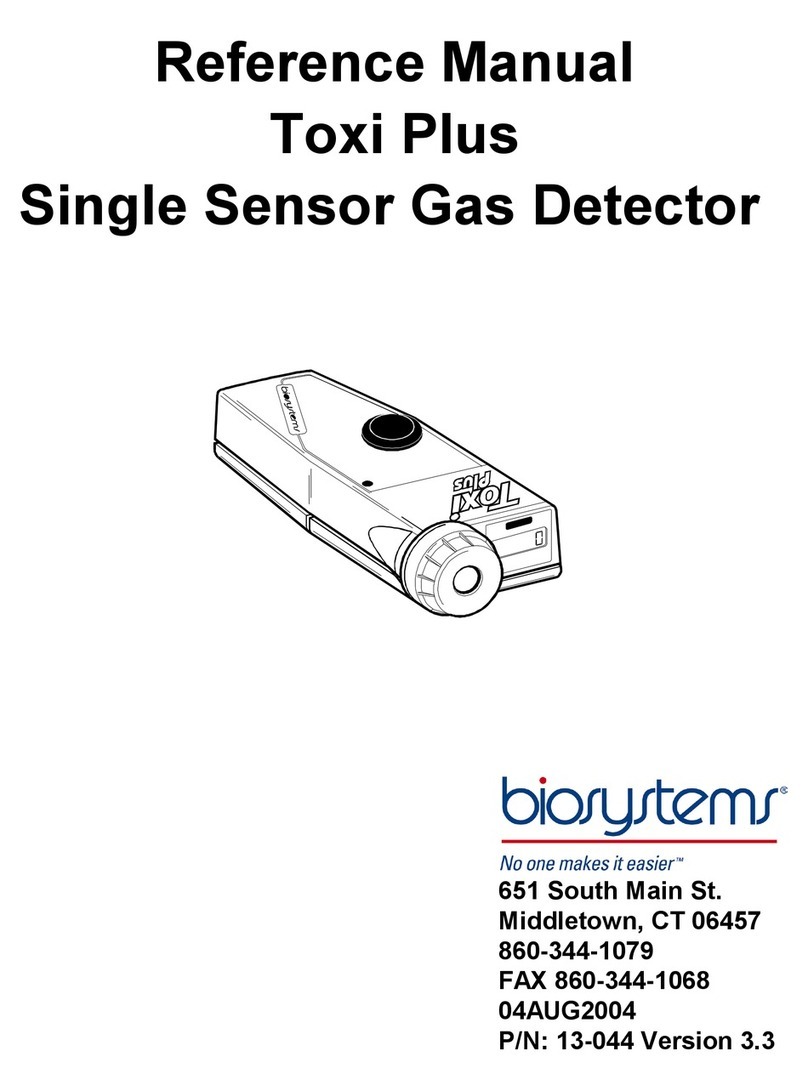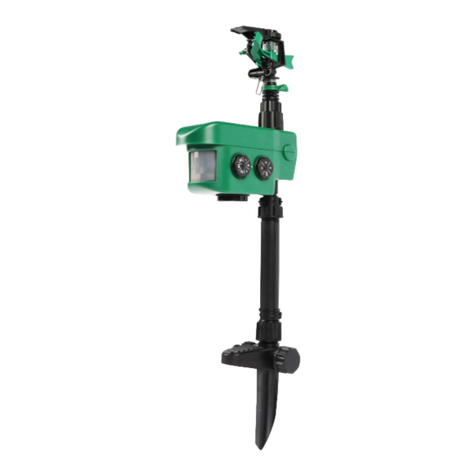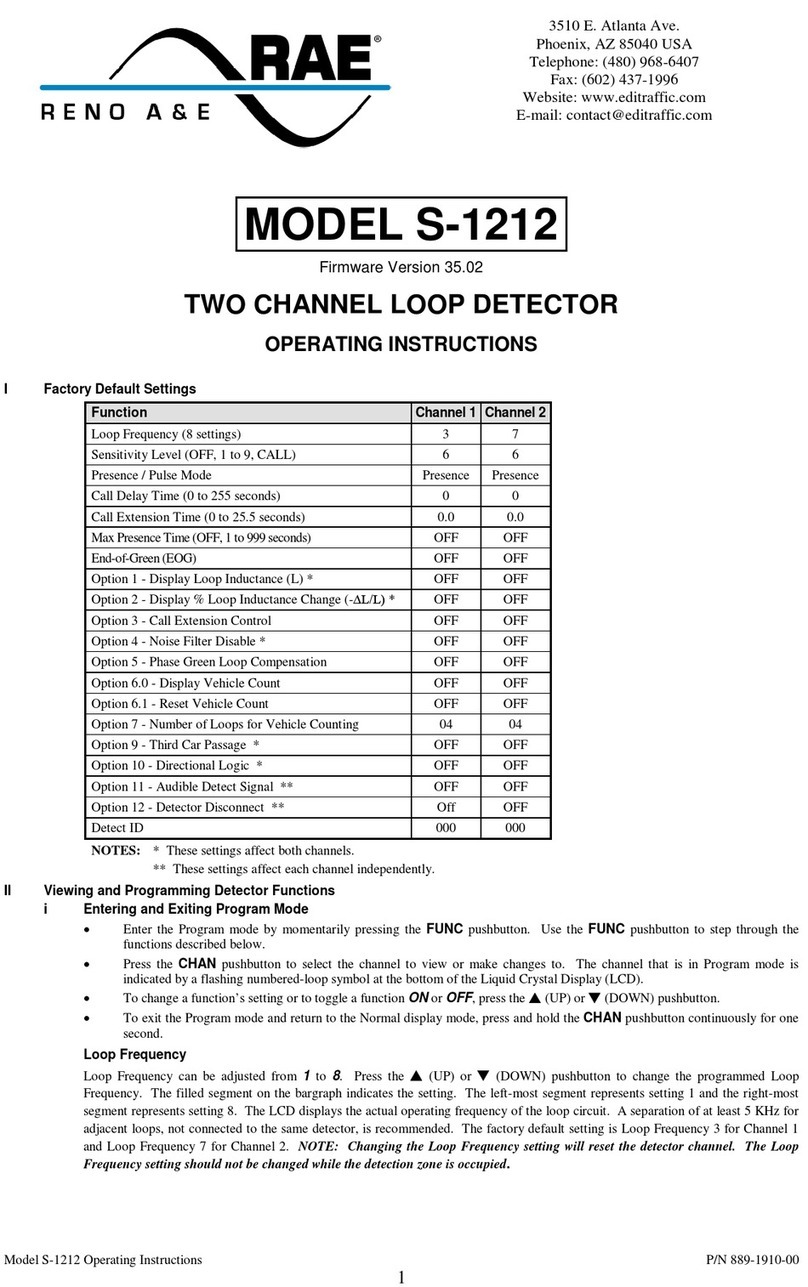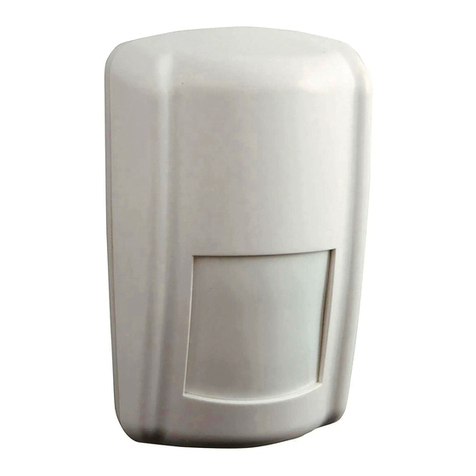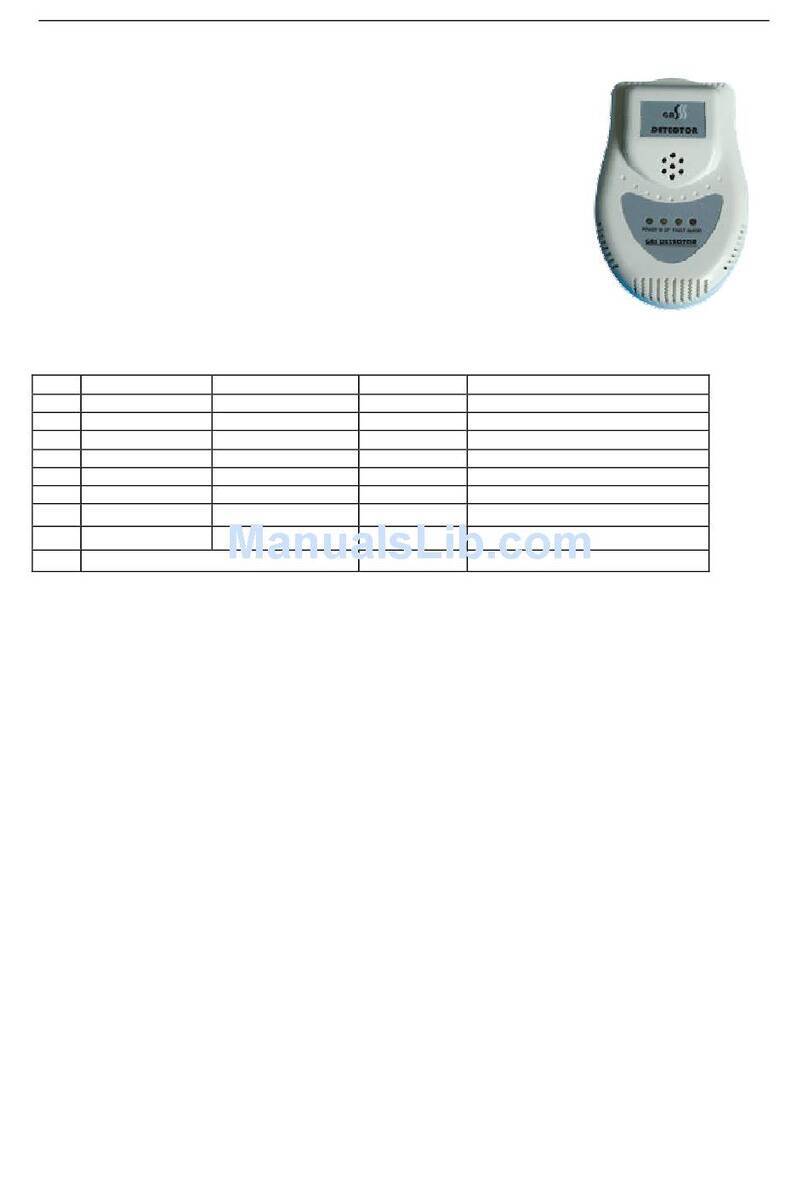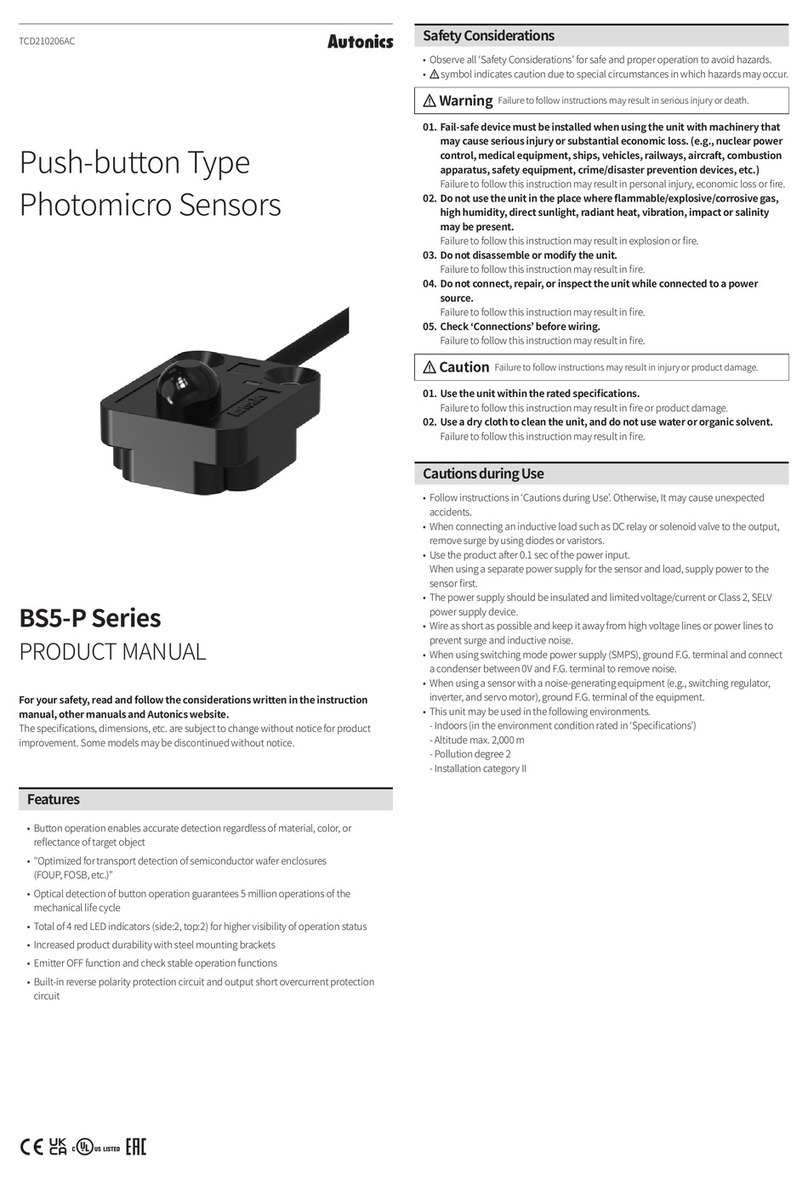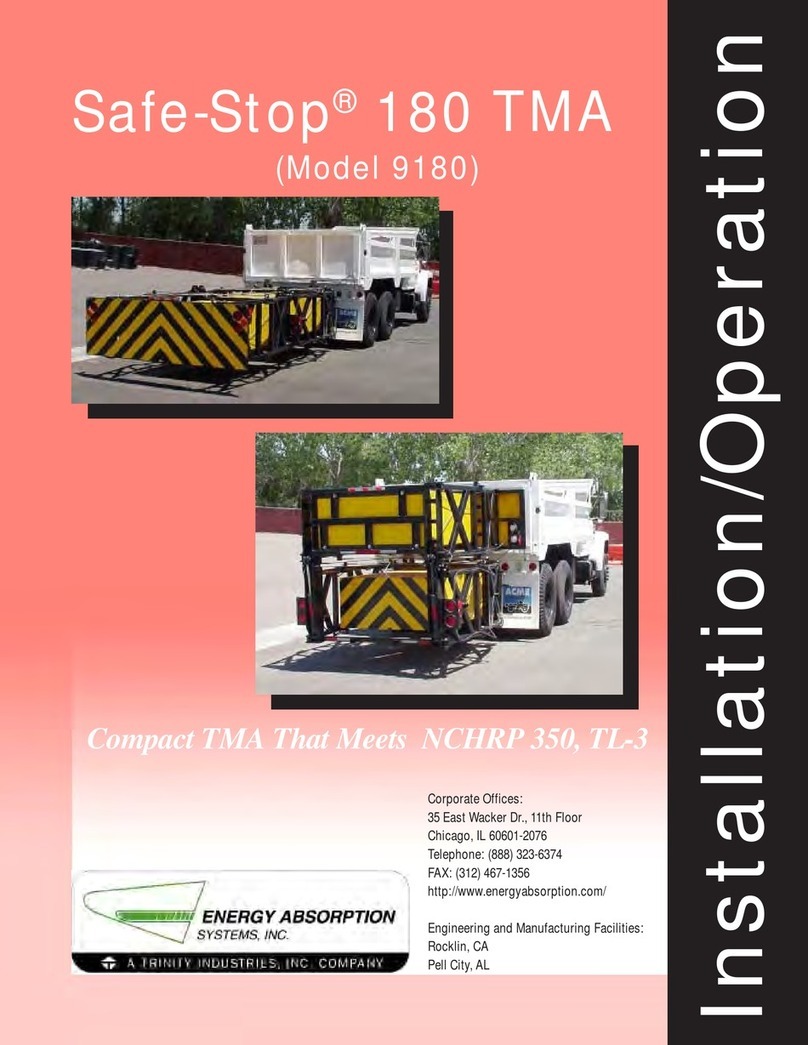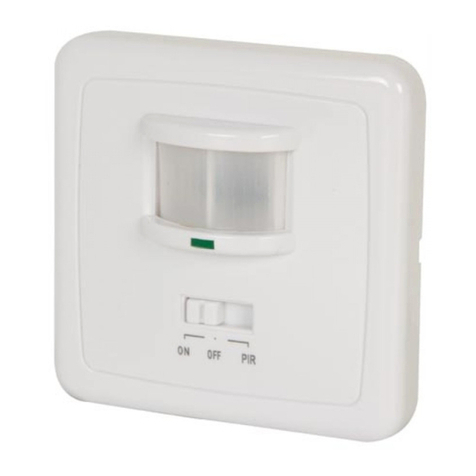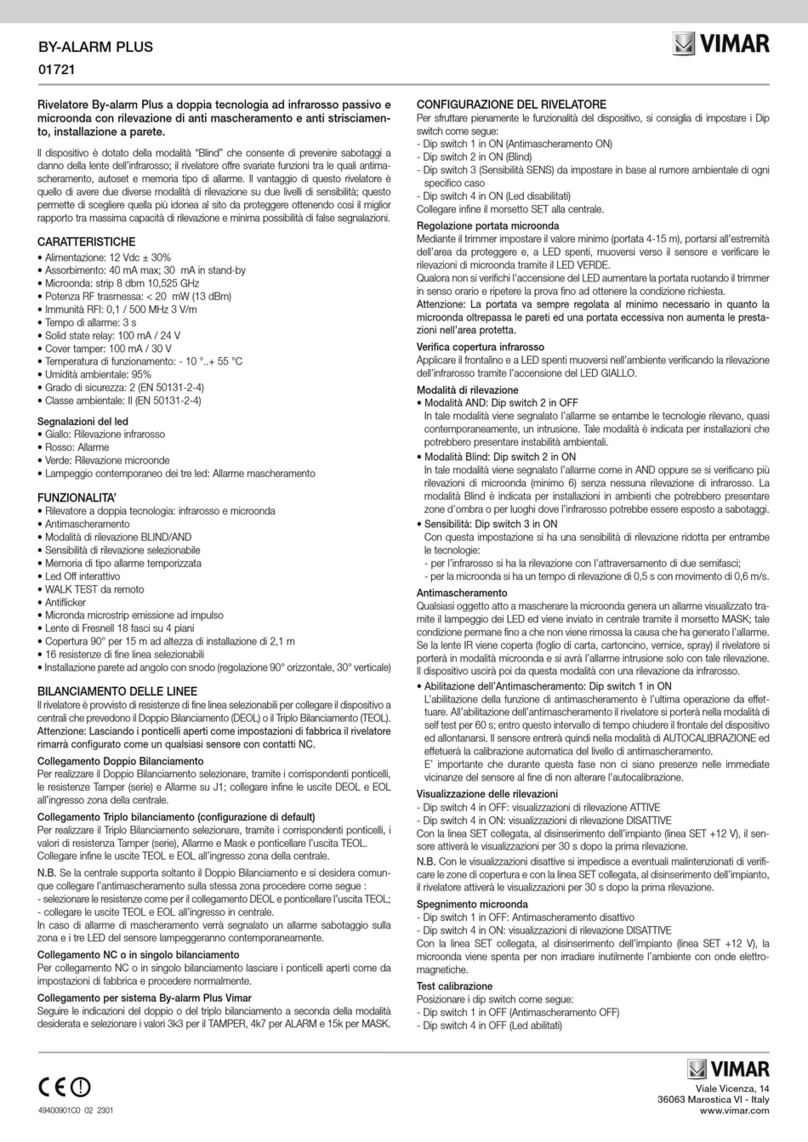biosystems MultiPro User manual

1
Reference Manual
MultiPro
Gas Detector
651 South Main Street
Middletown, CT 06457
800 711-6776 860 344-1079
Fax 860 344 –1068
11MAY2007
P/N 13-278 Version 1.41
http://www.biosystems.com

1
MULTIPRO PERSONAL PORTABLE GAS DETECTORS HAVE BEEN
DESIGNED FOR THE DETECTION AND MEASUREMENT OF
POTENTIALLY HAZARDOUS ATMOSPHERIC CONDITIONS
IN ORDER TO ASSURE THAT THE USER IS PROPERLY WARNED
OF POTENTIALLY DANGEROUS ATMOSPHERIC CONDITIONS, IT
IS ESSENTIAL THAT THE INSTRUCTIONS IN THIS REFERENCE
MANUAL BE READ, FULLY UNDERSTOOD, AND FOLLOWED.
MultiPro
Reference Manual
Part Number 13-278
Version 1.41
Copyright 2007
by
Biosystems LLC
Middletown, Connecticut 06457
All rights reserved.
No page or part of this operation manual may be reproduced in any form without
written permission of the copyright owner shown above.
Biosystems reserves the right to correct typographical errors.

2
Table of Contents
CERTIFICATION INFORMATION 4
SIGNAL WORDS 4
WARNINGS AND CAUTIONS 4
1. DESCRIPTION 6
1.1 Methods of sampling 6
1.2 Multi-sensor capability 6
1.3 Calibration 6
1.4 Alarm logic 7
1.4.1 Atmospheric hazard alarms 7
1.4.2 Low battery alarms 7
1.4.3 Sensor over range alarms. 7
1.4.4 LEL response failure due to lack of O2alarm 7
1.4.5 Security beep/flash 7
1.4.6 Latching peak alarms 8
1.4.7 Fault detection 8
1.5 Other electronic safeguards 8
1.5.1 Heartbeat 8
1.6 Sensors 8
1.7 Optional sample draw pump 8
1.7.1 Special precautions when using the MultiPro pump 9
1.8 Data storage 9
1.8.1 Black box data recorder 9
1.8.2 Event logger 9
1.9 MultiPro design components 9
1.10 MultiPro standard accessories 10
1.10.1 Alkaline MultiPro detectors 10
1.10.2 Li-Ion MultiPro detectors 10
1.11 MultiPro kits 10
1.11.1 MultiPro Confined Space Kits 10
1.11.2 MultiPro Value Packs 10
2. BASIC OPERATIONS 10
2.1 Turning the MultiPro On 10
2.1.1 Start up with pump 11
2.2 Operating Logic 12
2.3 Turning the MultiPro Off 12
2.4 Alarms 13
2.4.1 Warning Alarms 13
2.4.2 Danger Alarms 13
2.4.3 STEL Alarms 13
2.4.4 TWA Alarms 13
2.4.5 Low battery alarms 13
2.4.6 Sensor over range alarms 14
2.4.7 LEL failure due to lack of oxygen alarm 14
2.5 PC connection via infrared port 14
2.6 Error Messages 14
3. SAMPLING 15
3.1 Manual sample draw kit 15
3.1.1 Manual sample draw kit usage 15
3.2 Motorized sample draw pump 15
3.2.1 Starting the motorized sample pump 16
3.2.2 Turning off the pump 16

3
3.2.3 Pump low flow alarm 16
3.3 Sample draw probe 17
4. CALIBRATION 17
4.1 Functional (Bump) testing 17
4.2 Fresh Air/Zero Calibration 18
4.2.1 Fresh air/zero calibration failure 18
4.2.2 Manual fresh air / zero calibration 19
4.3 Span Calibration 19
4.3.1 Span calibration failure: Toxic and LEL sensors 20
4.3.2 Span calibration failure: Oxygen sensors 20
5. MAINTENANCE 21
5.1 Batteries 21
5.2 Replacing alkaline batteries 21
5.3 Maintaining Li-Ion battery packs 21
5.3.1 Storage guidelines for the Li-Ion battery 22
5.3.2 Charging guidelines for Li-Ion battery 22
5.3.3 Charging procedure for Li-Ion battery 22
5.3.4 Charging with the pump attached. 22
5.3.5 Battery troubleshooting 22
5.4 Sensor replacement 22
5.4.1 Sensor replacement (Not Duo-Tox) 22
5.4.2 Duo-Tox sensor replacement 23
5.5 Sample probe assembly 24
5.5.1 Changing sample probe filters 24
5.5.2 Changing sample probe tubes (wands) 24
5.6 MultiPro Pump Maintenance 25
5.6.1 Replacing pump filters 25
6. DIRECT PROGRAMMING 25
6.1 Entering the Advanced Menu 25
6.2 Set options 26
6.3 Set time 26
6.4 Set date 26
6.5 Set alarms 26
6.6 Set cal gas 27
6.7 Set cal due 27
6.8 Set bump test due 27
6.9 Setup accept 27
APPENDICES 28
Appendix A Toxic gas measurement – Warning, Danger, STEL and TWA alarms 28
1. Warning and Danger Alarms 28
2. Time Weighted Average (TWA): 28
3. Short Term Exposure Limits (STEL): 28
Appendix B Calibration Frequency Recommendation 29
Appendix C: Calibration Frequency 29
Appendix C MultiPro Sensor Information 30
Appendix D Toxic Sensor Cross-Sensitivity 30
Appendix E: Basic Parts List 30
MultiPro Remote Sampling Accessories 30
MultiPro Sensors 30
MultiPro Charging & Datalogging Accessories 30
Appendix F Biosystems Standard Warranty Gas Detection Products 31

4
Certification Information
The MultiPro carries the following certifications:
UL Class I Division 1 Groups A,B,C,D Temp Code T4
CSA Class I, Division 1, Groups A,B,C,D Temp Code T4
(Per CSA C22.2 No. 152, only the combustible gas detection portion of this
instrument has been assessed for performance)
ATEX Certification:
II 2 G EEx ia d IIC T4
UL International DEMKO A/S 05 ATEX 0424116X
IECEx Certification:
Ex ia d IIC T4
IECEx UL 07.0003X
Signal Words
The following signal words, as defined by ANSI Z535.4-1998, are used in
the MultiPro Reference Manual.
indicates an imminently hazardous situation which, if
not avoided, will result in death or serious injury.
indicates a potentially hazardous situation which, if not
avoided, could result in death or serious injury.
indicates a potentially hazardous situation, which if not
avoided, may result in moderate or minor injury.
CAUTION used without the safety alert symbol indicates a potentially
hazardous situation which, if not avoided, may result in property damage.
Warnings and Cautions
1. The MultiPro personal, portable gas detector has been
designed for the detection of dangerous atmospheric conditions. An alarm
condition indicates the presence of a potentially life-threatening hazard and should
be taken very seriously.
2. In the event of an alarm condition it is important to follow
established procedures. The safest course of action is to immediately leave the
affected area, and to return only after further testing determines that the area is
once again safe for entry. Failure to immediately leave the area may result in
serious injury or death.
3. The MultiPro must be located in a non-hazardous location
whenever alkaline batteries are removed from the alkaline battery pack.
Removal of the alkaline batteries from the battery pack in a hazardous area may
impair intrinsic safety.
4. Use only Duracell MN1500 or Ultra MX1500, Eveready Energizer
E91-LR6, Eveready EN91 batteries in the alkaline battery pack. Substitution of
batteries may impair intrinsic safety.
5. To reduce the risk of explosion, do not mix old or used
batteries with new batteries and do not mix batteries from different manufacturers.
6. Do not charge the MultiPro with any charger other than the
appropriate Biosystems MultiPro charger. Standard versions of the MultiPro must

5
be charged with the UL/CSA-approved charger, which is Biosystems part number
54-49-103-1. European versions of the MultiPro must be charged with the ATEX-
approved charger, which is Biosystems part number 54-49-103-5.
7. The MultiPro must be located in a non-hazardous location
during the charging cycle. Charging the MultiPro in a hazardous location may
impair intrinsic safety.
8. MultiPro rechargeable battery packs are supplied with
Panasonic CGA103450 Lithium-Ion batteries. These batteries are not replaceable by
the user. The rechargeable pack must be obtained from Biosystems and replaced as
an assembly.
9. The accuracy of the MultiPro should be checked periodically
with known concentration calibration gas. Failure to check accuracy can lead to
inaccurate and potentially dangerous readings. (The Canadian Standards
Association (CSA) requires an accuracy check using known concentration
calibration gas prior to each day’s use.)
10. Fresh air/zero calibrations may only be performed in an
atmosphere that is known to contain 20.9% oxygen, 0.0% LEL and 0 PPM toxic gas.
11. The accuracy of the MultiPro should be checked immediately
following any known exposure to contaminants by testing with known concentration
test gas before further use. Failure to check accuracy can lead to inaccurate and
potentially dangerous readings.
12. A sensor that cannot be calibrated or is found to be out of
tolerance should be replaced immediately. An instrument that fails calibration may
not be used until testing with known concentration test gas determines that
accuracy has been restored, and the instrument is once again fit for use.
13. Do not reset the calibration gas concentration unless you are
using a calibration gas concentration that differs from the one that is normally
supplied by Biosystems for use in calibrating the MultiPro.
Customers are strongly urged to use only Biosystems calibration materials when
calibrating the MultiPro. Use of non-standard calibration gas and/or calibration kit
components can lead to dangerously inaccurate readings and may void the standard
Biosystems warranty.
14. Use of non-standard calibration gas and/or calibration kit
components when calibrating the MultiPro can lead to inaccurate and potentially
dangerous readings and may void the standard Biosystems warranty.
Biosystems offers calibration kits and long-lasting cylinders of test gas
specifically developed for easy MultiPro calibration. Customers are strongly
urged to use only Biosystems calibration materials when calibrating the
MultiPro.
15. Substitution of components may impair intrinsic safety.
16. For safety reasons this equipment must be operated and
serviced by qualified personnel only. Read and understand this reference manual
before operating or servicing the MultiPro.
17. A rapid up-scale reading followed by a declining or erratic
reading may indicate a hazardous combustible gas concentration that exceeds the
MultiPro’s zero to 100 percent LEL detection range.
18. The MultiPro is not designed for use in oxygen enriched
atmospheres.
19. Do not use the MultiPro pump for prolonged periods in an
atmosphere containing a concentration of solvent or fuel that may be greater than 10%
LEL.

6
1. Description
The MultiPro is
a multi-sensor
gas detector
that can be
configured to
meet a wide
variety of user
requirements.
This chapter
provides an
overview of many of the features of the
MultiPro. More detailed descriptions of the
specific features of the MultiPro are
contained in the subsequent chapters of this
manual.
1.1 Methods of sampling
The MultiPro may be
used in either
diffusion or sample-
draw mode. In
either mode, the gas
sample must reach
the sensors for the
instrument to
register a gas
reading. The
sensors are located at the bottom of the
instrument. There are three distinct sensor
ports that allow air to reach the individual
sensors.
The sensor ports must
be kept free of obstruction. Blocked
sensor ports can lead to inaccurate and
potentially dangerous readings.
In diffusion mode, the atmosphere being
measured reaches the sensors by diffusing
through the vents at the bottom of the
instrument. Normal air movements are
enough to carry the sample to the sensors.
The sensors react quickly to changes in the
concentrations of the gases being measured.
Diffusion-style operation monitors only the
atmosphere that immediately surrounds the
detector.
The MultiPro can also be used to sample
remote locations with the hand-aspirated
sample-draw kit or with the motorized,
continuous sample draw pump. During
remote sampling, the gas sample is drawn
into the sensor compartment through the
probe assembly and a length of tubing.
Remote sampling operations only monitor the
atmosphere at the end of the sample draw
probe.
Use of the hand-aspirated sample draw
kits is covered in section 3.1.
Use of the motorized sample draw pump
is covered in section 3.2.
A detailed description of the MultiPro
probe assembly is given in section 5.5.
1.2 Multi-sensor capability
The MultiPro can be configured to
simultaneously monitor oxygen, carbon
monoxide, hydrogen sulfide and combustible
gases and vapors. All sensors are
replaceable in the field. Each of the
MultiPro’s sensor channels is configured for
a specific type of sensor.
Note: It is necessary to verify the
accuracy of the MultiPro by calibration
with known concentration test gas
whenever a change is made to the
sensors installed in the instrument.
Calibration procedures are discussed in
detail in Chapter 4.
The MultiPro uses electrochemical toxic gas
sensors that have been designed to minimize
the effects of common interfering gases.
These sensors provide accurate, dependable
readings for toxic gases commonly
encountered during confined space entry and
other industrial applications.
Different measurement units are used
depending on the gas being measured.
Type of Hazard Measurement unit
Oxygen (O2) Percentage by
volume
Combustible gas Percentage of lower
explosive limit
(%LEL)
Carbon Monoxide,
Hydrogen Sulfide
Parts per million
(PPM)
Table 1.2. MultiPro Units of Measurement.
1.3 Calibration
The MultiPro detector features fully automatic
fresh air and span calibration.
The accuracy of the
MultiPro should be checked periodically
with known concentration calibration gas.
Failure to check accuracy can lead to
inaccurate and potentially dangerous
readings. (The Canadian Standards
Association (CSA) requires an accuracy
check using known concentration
calibration gas prior to each day’s use.)
Calibration procedures are discussed in
detail in Chapter 4.

7
Recommended calibration frequency is
discussed in Appendix B.
1.4 Alarm logic
MultiPro gas alarms can be adjusted with
Biosystems BioTrak Software through a PC
with an IrDA port or directly with the MODE
button (see Chapter 6 for direct programming
instructions). Alarms may be set anywhere
within the nominal range of the specific
sensor type. When an alarm set point is
exceeded a loud audible alarm sounds, and
the bright red LED alarm lights flash.
1.4.1 Atmospheric hazard alarms
MultiPro portable gas
detectors have been designed for the
detection of deficiencies of oxygen,
accumulations of flammable gases and
vapors, and accumulations of specific
toxic gases. An alarm condition
indicating the presence of one or more
of these potentially life-threatening
hazards should be taken very seriously.
In the event of an alarm
condition it is important to follow
established procedures. The safest
course of action is to immediately leave
the affected area, and to return only after
further testing determines that the area is
once again safe for entry. Failure to
immediately leave the area may result in
serious injury or death.
A rapid up-scale
reading followed by a declining or
erratic reading may indicate a
hazardous combustible gas
concentration that exceeds the
MultiPro’s zero to 100 percent LEL
detection range.
The combustible gas alarm is activated when
the percent LEL (Lower Explosive Limit) gas
concentration exceeds any pre-set alarm
level.
Two oxygen alarm set points have been
provided; a danger alarm for low
concentrations associated with oxygen
deficiency and a warning alarm for high
concentrations associated with oxygen
enrichment.
Four alarm set points have been provided for
each toxic gas sensor: Warning, Danger,
STEL (Short Term Exposure Limit) and TWA
(Time Weighted Average).
S
E
N
S
O
R
W
A
R
N
I
N
G
D
A
N
G
E
R
S
T
E
L
T
W
A
CO 35 100 100 35
H2S 10 20 15 10
MultiPro Default Toxic Sensor Alarm Levels
Appendix A discusses alarm levels and
factory default alarm settings.
1.4.2 Low battery alarms
The MultiPro may be equipped with either
rechargeable Lithium Ion (Li-Ion) or alkaline
battery packs. The MultiPro includes multi-
staged alarms for either battery type to let the
user know that the battery is running low.
For detailed information concerning the
low battery alarms, see section 2.4.5.
Use only Duracell
MN1500 or Ultra MX1500, Eveready
Energizer E91-LR6, Eveready EN91
batteries. Substitution of batteries may
impair intrinsic safety.
1.4.3 Sensor over range alarms.
The MultiPro will go into alarm if a sensor is
exposed to a concentration of gas that
exceeds its established range. In the case of
an LEL reading that exceeds 100% LEL, the
LEL channel will be automatically disabled by
the instrument and the instrument will remain
in constant alarm until it is turned off, brought
to an area that is known to be safe, and then
turned back on. The display will show “OL”
in place of the sensor reading for any
channel that has gone into over range alarm.
See section 2.4.5 for further details on
sensor over range alarms.
A sensor range chart is provided in
Appendix C.
In the event of an LEL
overrange alarm the MultiPro must be
turned off, brought to an area that is
known to be safe and then turned on
again to reset the alarm.
1.4.4 LEL response failure due to lack of
O2alarm
The MultiPro features automatic warning
against LEL sensor response failure due to
lack of oxygen. See section 2.4.7 for details.
1.4.5 Security beep/flash
The MultiPro includes a security beep
function that is designed to notify the user

8
that the instrument is powered up and
running. Once enabled the MultiPro will emit
a short audible beep and give a short flash
on the LED at a user-defined interval. The
security beep/flash function may be enabled
and the interval may be changed with
BioTrak software or directly with the MODE
button (see Chapter 6 for direct programming
instructions).
1.4.6 Latching peak alarms
The MultiPro’s alarms are self-resetting
unless the alarm latch is enabled. With the
MultiPro’s alarm latch enabled, the audible
and visible alarms will continue to sound after
the atmospheric hazard has cleared. To
reset the alarms, simply press the MODE
button. If the alarm latch is disabled and the
alarm condition is no longer present, the
instrument automatically returns to normal
operation, and the visible and audible alarms
cease without further input from the user.
1.4.7 Fault detection
MultiPro software includes a number of
additional alarms designed to ensure the
proper operation of the instrument. When
the MultiPro detects that an electronic fault or
failure condition has occurred, the proper
audible and visible alarms are activated and
an explanatory message or message code is
displayed.
The MultiPro is
designed to detect potentially life
threatening atmospheric conditions. Any
alarm condition should be taken
seriously. The safest course of action is
to immediately leave the affected area,
and return only after further testing
determines that the area is once again
safe for entry.
1.5 Other electronic safeguards
Several automatic programs prevent
tampering and misuse of the MultiPro by
unauthorized persons. Each time the
detector is turned on, the MultiPro
automatically tests the LED alarm light,
audible alarm, internal memory and pump
status (if so equipped). The battery is
monitored continuously for proper voltage.
The MultiPro also monitors the connection of
sensors that are currently installed. The
detection of any electronic faults causes the
activation of the audible and visible alarms
and causes the display of the appropriate
explanatory message.
1.5.1 Heartbeat
At the center of the display is a heart symbol
that will blink every few seconds to show that
the instrument is functioning normally.
1.6 Sensors
The MultiPro can be configured to
simultaneously monitor oxygen, carbon
monoxide, hydrogen sulfide and combustible
gases and vapors. The sensor configuration
of the MultiPro may be specified at the time
of purchase, or changed in the field by
appropriately trained personnel.
Note: A CF Value must be entered into
the instrument when replacing the 54-49-
24 CO/H2S sensor. Instructions are
included with the replacement sensor.
Replacement sensor part numbers and
sensor ranges are given in Appendix B.
Sensor cross-sensitivity figures are given
in Appendix C.
A sensor that cannot be
calibrated or is found to be out of
tolerance must be replaced immediately.
An instrument that fails calibration may
not be used until testing with known
concentration test gas determines that
accuracy has been restored, and the
instrument is once again fit for use.
Calibration procedures are discussed in
detail in Chapter 4.
1.7 Optional sample draw pump
A motorized sample-draw pump is available
for the MultiPro for situations requiring
continuous "hands free" remote monitoring.
Use only Biosystems
part number 54-49-102 sample draw pump
with the UL/CSA-approved version of the
MultiPro. Use only Biosystems part
number 54-49-102-5 sample draw pump
with the ATEX-approved version of the
MultiPro.
The pump contains a
pressure sensor that
detects restrictions in
airflow caused by water
or other obstructions
being drawn into the
unit and immediately
acts to turn the pump
off in order to protect
the sensors, pump, and
other MultiPro components from damage.
Pump status is continuously monitored by the
MultiPro microprocessor. When the pump is

9
active and functioning properly, “PUMP” is
displayed near the center of the LCD display.
Low flow or other pump fault conditions
activate audible and visible alarms and cause
the display of the appropriate explanatory
message.
1.7.1 Special precautions when using
the MultiPro pump
The internal material used in the MultiPro’s
pump diaphragm seal is susceptible to
temporary compromise by high levels of
combustible fuels and solvents. If the
MultiPro is being used in an atmosphere that
may contain concentrations of combustible
fuels and solvents that exceed 10% LEL, test
the pump frequently to ensure that the seals
have not been compromised.
To test the pump, block the sample inlet with
a finger. The pump should go into alarm. If
the pump fails to go into alarm while the inlet
is blocked, the pump is not working properly
and the MultiPro may not be providing an
accurate reading. If the pump test fails, the
safest course of action is to immediately
leave the affected area, and return only
after further testing determines that the
area is once again safe for entry.
Do not use the pump for
prolonged periods in an atmosphere
containing a concentration of solvent or
fuel that may be greater than 10% LEL.
1.8 Data storage
The MultiPro includes a black box data
recorder and an event logger as standard
features.
1.8.1 Black box data recorder
A black box data recorder is a standard
feature in the MultiPro. The “black box” is
continually in operation whether the user is
aware of it or not. The black box stores
important information such as gas readings,
turn-on times, turn-off times, temperatures,
battery conditions, the most recent calibration
date and settings, types of sensors currently
installed, sensor serial numbers, warranty
expiration and service due dates, and current
alarm settings.
There is a finite amount of memory storage
available in the black box data recorder.
Once the memory is “full”, the MultiPro will
begin to write the new data over the oldest
data. The black box data recorder will store
approximately 41 hours of data in one-minute
increments before it begins to write new data
over the oldest data. In this way, the newest
data is always conserved.
To extract the information from the black box
data recorder, the MultiPro must be returned
to Biosystems. Once the data is downloaded
from the instrument, a report will be
generated. The unit and the report will then
be returned to the user. Simply call
Biosystems’ Instrument Service Department
to obtain a return authorization number.
There is no charge for the downloading
service, but the user is responsible for any
freight charges incurred.
The “black box” data recorder in the MultiPro
can be upgraded to a fully enabled
datalogger at any time. All that is required is
the activation code that corresponds to the
serial number of the MultiPro.
1.8.2 Event logger
The event logger in the MultiPro stores data
associated with alarm conditions. Each
(alarm) event includes the following data for
each of the installed sensors: Sensor type,
Max reading, average reading, start time,
end time and duration of the event. The
MultiPro stores the 20 most recent events.
Once 20 events have been stored, the
MultiPro will begin to systematically overwrite
the data from the oldest event in memory
with data from new events. One event may
be a combination of different alarms
occurring simultaneously or in immediate
succession. The event logger may be
downloaded using Biosystems' BioTrak
software. The PC must be equipped with
IrDA to provide a connection.
1.9 MultiPro design components
1. Case: The instrument is enclosed in a
solid PC (polycarbonate) case with TPE
(rubber) overmold.
2. Front face: The front face of the
instrument houses the MODE button,
LCD (liquid crystal display), LED alarm
light, IrDA port and audible alarm.
3. Display: A liquid crystal display (LCD)
shows readings, messages, and other
information.
4. Alarm light: A top and front-mounted
LED (light emitting diode) alarm lights
provides a visual indication of alarm
state. The light emits a bright red light
when the instrument is in alarm.
5. Infrared Port: The infrared port is
located next to the MODE button on the
front face of the instrument. The infrared

10
port is used for communications between
the MultiPro and a PC.
6. On / Off "MODE" button: The large
black push-button on the front of the
instrument is called the "MODE" button.
The MODE button is used to turn the
MultiPro on and off as well as to control
most other operations, including the
automatic calibration adjustment.
7. Sensor compartment cover: The
sensors are located in a vented
compartment at the bottom of the
instrument.
8. Audible alarm port: A cylindrical port
extending through the front of the
instrument just above the display houses
the loud audible alarm. The waterproof
audible alarm seats directly to the rubber
inner-liner to protect the instrument
against leakage or exposure to liquids.
9. Battery pack: Two types of
interchangeable battery packs
(rechargeable Lithium Ion (Li-Ion) and
disposable alkaline) are available for use.
Li-Ion battery packs may be recharged
while the pack is installed in the
instrument, or removed from the
instrument for separate recharging.
10. Battery charger connector: A water-
resistant connector at the bottom of the
case assembly is used to connect the
MultiPro to the “drop in” style charger.
11. Back surface: A sturdy clip allows the
user to wear the MultiPro on a belt or
other article of clothing.
1.10 MultiPro standard accessories
Standard accessories included with every
MultiPro include calibration adapter,
additional tubing for use during calibration,
reference manual and quick reference card.
The optional sample draw kit consists of a
sample draw / calibration adapter, squeeze
bulb, replacement sample probe filters, and
ten feet of tubing. The sample probe is
available separately.
Standard configurations of the MultiPro are
delivered in a cardboard box with cardboard
inserts.
1.10.1 Alkaline MultiPro detectors
If the MultiPro has been purchased as an
alkaline instrument, the standard accessories
include a set of 3 disposable AA alkaline
batteries.
1.10.2 Li-Ion MultiPro detectors
If the MultiPro has been purchased as a Li-
Ion rechargeable instrument, the standard
accessories include Li-Ion battery pack and a
slip-in MultiPro charger.
1.11 MultiPro kits
MultiPro detectors may also be purchased as
part of a complete kit that includes calibration
gas, fixed-flow regulator and a hard-shell
carrying case.
1.11.1 MultiPro Confined Space Kits
In addition to the standard accessories listed
above, Confined Space Kits also include
calibration fittings, fixed-flow regulator with
pressure gauge, and appropriate large
cylinder of calibration gas in a foam-lined,
waterproof hard-shell carrying case.
1.11.2 MultiPro Value Packs
MultiPro Value Packs include an alkaline
MultiPro, all standard accessories, calibration
fittings, small cylinder(s) of calibration gas,
and fixed flow regulator in a foam-lined non-
waterproof hard-shell carrying case.
2. Basic Operations
The MultiPro is a true one-button gas
detector. The MODE button is located on the
front of the instrument and controls all field-
level operations including the following
•Turning the MultiPro on and off
•Turning on the backlight
•Viewing the MAX, STEL and TWA
reading screens
•Initiating the calibration sequence
2.1 Turning the MultiPro On
To turn the MultiPro on, press and hold the
MODE button for one second. The first
screen shown is the test screen for the LCD.
All sections should be darkened. The test
screen will be followed by a screen showing
the instrument firmware version. “dL” will
appear in the upper right for instruments with
a fully enabled datalogger.
→
The sensor screen and instrument serial
number screen will then be shown.
→

11
If the MultiPro is equipped with a fully
enabled datalogger, the following screen will
be shown. The time figure in the upper right
corner indicates the sampling interval in
minutes and seconds. Instruments without a
fully enabled datalogger will show display
“not a datalog”
or
The sampling interval may be modified using
BioTrak Software.
In the MultiPro, a one-minute sampling
interval will result in the ability to store a
minimum of 41 hours of readings before the
oldest data is overwritten by new data.
The time will then be shown followed by the
date:
→
The instrument will display “Self Test” as it
performs a few operational checks. During
the self-test, the MultiPro tests for installed
sensors, performs a system memory check
and tests to see if a motorized pump is
attached to the instrument. If a pump is
detected, it will be briefly activated during the
self-test. For details on start up procedures
for pump-equipped MultiPro instruments see
section 2.1.1 below.
For instructions on changing the time and
date with the MODE button, see section 6
below.
The instrument temperature will then be
shown.
→
The warning alarm levels screen will then be
shown followed by the danger, STEL and
TWA alarm levels screens.
→
→
For more information concerning STEL
and TWA alarms, see sections 2.4.3 and
2.4.4.
After the alarm screens, the calibration due
screen will be shown with the number of days
until the next calibration. The instrument will
then proceed to the current gas readings
screen. If calibration is due, “Cal due now”
will be shown followed by “needs cal”. The
user will need to acknowledge the message
by pressing the MODE button. Once the
MODE button is pressed, the MultiPro will
continue to the current gas readings screen
and the appropriate calibration due icon will
blink every 5 seconds to remind the use that
the instrument is past due for calibration.
or
If the Bump Test Interval setting is enabled,
the bump interval screen will be shown. The
bump due status will be shown in days or
hours.
Note: The Bump Test Interval and bump
test reminder are used exclusively with
the MultiPro IQ Express Dock.
or
Following the calibration status screens, the
MultiPro will proceed to the current gas
readings screen.
2.1.1 Start up with pump
MultiPro instruments that are equipped with a
built-in motorized sample draw pump will
have a slightly longer start up sequence.
After the calibration status screens, the

12
MultiPro will prompt you to leak test the
pump.
Note: The sample probe assembly must
be attached when the pump is started.
→
Block the sampling inlet by placing a finger
over the end of the sample probe assembly.
Once the MultiPro
recognizes that the test
is passed, it will instruct
you to remove the
blockage.
Once the blockage is
removed, the MultiPro
will proceed to the current gas readings
screen.
If the instrument is unable to detect the
vacuum resulting from the pump blockage,
the test will fail and you will be directed to
remove the pump.
↔
For information concerning proper
attachment of the sample probe assembly to
pump-equipped MultiPro instruments, see
section 3.1.
2.2 Operating Logic
Once the MultiPro has
completed the start up
sequence, the current gas
readings screen will be
shown. At the center of
the display is a heartbeat
that will “beat” every few
seconds to show that the
instrument is functioning
normally.
If the MultiPro is due for
fresh air/zero calibration,
the “0-Cal” will flash on the
LCD once every 5
seconds as a reminder. If
the MultiPro is due for
span calibration, the
calibration bottle icon will
be shown. Both “0-Cal”
and the calibration bottle
icon will be shown if the instrument is due for
both span and fresh air calibration.
When a sensor is not
detected, the reading in
the designated sensor
channel will be blank. In
the example at right, the
LEL sensor has not been
detected.
If the MultiPro recognizes
that the pump is
attached, “Pump” will be
displayed in the current
gas readings screen
The battery icon gives an
indication of how much power is left in the
battery. The illustration below shows the
stages of the battery from full to empty (top to
bottom).
Battery charge greater than
80%
Battery charge between 50%
and 80%
Battery charge between 25%
and 50%
Battery charge less than 25%
To turn on the backlight press the MODE
button once. To view the MAX readings
screen, press the MODE button a second
time. Press the MODE button a third time to
view the Short Term Exposure Limit (STEL)
readings. Press the MODE button again to
view the Time Weighted Averages (TWA) for
the operating session.
Note: The MultiPro must be in continuous
operation for at least 15 minutes before it
will be able to calculate the TWA values.
For the first 15 minutes of any operating
session, the screen will show the length
of time that the instrument has been
operating instead of the TWA values.
2.3 Turning the MultiPro Off
To turn the MultiPro off, press and hold the
MODE button until the display reads
“Release Button”. “Please wait” will be
shown briefly and display will go blank.
→

13
2.4 Alarms
The MultiPro is configured with a series of
alarms that are designed to warn the user of
dangerous conditions.
The MultiPro is
designed to detect potentially life
threatening atmospheric conditions.
Any alarm condition should be taken
seriously. The safest course of action
is to immediately leave the affected
area, and return only after further
testing determines that the area is once
again safe for entry.
2.4.1 Warning Alarms
Warning alarms indicate a
dangerous atmospheric
condition that has not yet
risen to the level
necessary to initiate the
danger alarms. Warning
alarm levels are shown
during the start up sequence.
Warning alarms can be temporarily silenced
by pressing the MODE button if this option is
enabled with BioTrak.
2.4.2 Danger Alarms
Danger alarms indicate a
significantly hazardous
condition. As is the case
with the warning alarms,
the danger alarms are
shown in the start up sequence.
2.4.3 STEL Alarms
STEL (Short Term
Exposure Limit) alarm
values represent the
average concentration of
instrument readings for the
target gas for the most recently completed 15
minutes of operation. The default STEL
alarm level for the MultiPro CO sensor is
100PPM. The default STEL value for the
MultiPro H2S sensor is 15PPM.
2.4.4 TWA Alarms
TWA (Time Weighted
Average) values are
calculated by taking the
sum of exposure to a
particular toxic gas in the
current operating session
in terms of parts-per-million-hours and
dividing by an eight-hour period. The default
TWA alarm level for the MultiPro CO sensor
is 35PPM. The default TWA value for the
MultiPro H2S sensor is 10PPM.
2.4.5 Low battery alarms
When battery voltage is
reduced to approximately
3.55 volts, the battery icon
on the LCD will appear empty, which means
that a low battery condition exists.
If the battery icon is empty, leave the area
immediately. If the MultiPro is equipped with
an alkaline battery pack, proceed to an area
that is known to be safe area (containing
20.9% oxygen, 0% LEL and 0 PPM toxic
gases) and change the batteries. If the
MultiPro is equipped with a Li-Ion battery
pack, proceed to an area that is known to be
safe and recharge the battery pack.
Once the battery voltage reaches 3.45 volts
the MultiPro will go into a 30-minute battery
alarm. The warning alarm will sound and the
screen will display “Lo-Bat”, along with the
warning and alarm icons. The user will need
to acknowledge the low battery condition by
pressing the MODE button before the
instrument will resume monitoring. Once this
MODE button is pressed, the empty battery
cell and the caution icon will flash. After 15
minutes the warning will sound again to
indicate that there are now only 15 minutes
of battery life left. Once the second 15-
minute period has elapsed or once the
battery voltage reaches 3.2 volts, the
instrument will go into alarm for the last time,
notify the user that it is shutting itself and
proceed to turn itself off.
Alkaline battery replacement and Li-Ion
battery charging instructions are
contained in section 5.2 and 5.3.
The MultiPro must be
located in a non-hazardous location
during the charging cycle. Charging the
MultiPro in a hazardous location may
impair intrinsic safety.
The MultiPro must be
located in a non-hazardous location
whenever alkaline batteries are
removed from the alkaline battery pack.
Removal of the alkaline batteries from
the battery pack in a hazardous area
may impair intrinsic safety.
CAUTION Always turn the MultiPro off
prior to removing the battery pack.
Removal of the battery pack with the
instrument turned on may cause
corruption of stored data in the MultiPro.

14
2.4.6 Sensor over range alarms
The MultiPro will go into alarm if a sensor is
exposed to a concentration of gas that
exceeds its established range. In the case of
an LEL reading that exceeds 100% LEL, the
LEL channel will be automatically disabled by
the instrument and the alarm will latch
(remain on) until the instrument is turned off.
The MultiPro must be turned off, brought to
an area that is known to be safe (containing
20.9% oxygen, 0% LEL and 0 PPM toxic
gases), and then turned back on. The
display will show “---“ and “OL” alternately in
place of the sensor reading for any channel
that has gone into over range alarm.
→
A combustible sensor
overrange alarm indicates a potentially
explosive atmosphere. Failure to leave
the area immediately may result in
serious injury or death!
In the event of an LEL
overrange alarm the MultiPro must be
turned off, brought to an area that is
known to be safe (containing 20.9%
oxygen, 0% LEL and 0 PPM toxic gases),
and then turned on again to reset the
alarm.
2.4.7 LEL failure due to lack of oxygen
alarm
The LEL sensor in the MultiPro requires a
certain amount of oxygen to function
properly. When oxygen levels fall below 11%
by volume, the MultiPro will show “---“ in
place of the LEL reading and display “O2”,
“too” and “Lo” in successive screens in the
location typically used for the LEL reading.
→
→
2.5 PC connection via infrared
port
MultiPro instruments that
are equipped with a fully
enabled datalogger can be
downloaded to a PC using
Biosystems BioTrak or IQ
software through the
MultiPro’s infrared port. For the location of
the infrared port, see the illustration below.
1. With the MultiPro turned off, hold the
MODE button down until four beeps are
heard. Depending on the software
version, this will normally take between
10 and 20 seconds. “PC Connect” will be
shown once the infrared port has been
activated.
2. Align the infrared port on the MultiPro
with the PC’s infrared port to complete the
connection.
Note: For further instructions
concerning the download procedure for
the MultiPro, see the BioTrak or IQ
System manual as appropriate.
2.6 Error Messages
The MultiPro will display error messages
when it detects certain problems during
operation.
MULTIPRO Error definitions
Error Display Number
Unit Memory Bad 003
O2 Memory Bad 004
LEL Memory Bad 005
CO Memory Bad 006
H2S Memory Bad 007
DataloggerMemory 008

15
Bad
Invalid Memory Type 009
No Sensors Installed 010
Bad Temp Sensor 012
Bad Vibrating Alarm 014
If the MultiPro displays an error message,
contact Biosystems for further instructions.
3. Sampling
The MultiPro may
be used in either
diffusion or
sample-draw
mode. In either
mode, the gas
sample must reach
the sensors for the
instrument to
register a gas
reading. The
sensors are located at the bottom of the
instrument.
The sensor ports must
be kept free of obstruction. Blocked
sensor ports can lead to inaccurate and
potentially dangerous readings.
In diffusion mode, the atmosphere being
measured reaches the sensors by diffusing
through vents at the bottom of the
instrument. Normal air movements are
enough to carry the sample to the sensors.
The sensors react quickly to changes in the
concentrations of the gases being measured.
Diffusion-style operation monitors only the
atmosphere that immediately surrounds the
detector.
The MultiPro can also be used to sample
remote locations with either the hand-
aspirated sample-draw kit, or with the
motorized sample draw pump. During
remote sampling, the gas sample is drawn
into the sensor compartment through the
probe assembly and a length of tubing.
3.1 Manual sample draw kit
The manual sample draw kit is comprised of
a sample draw probe, 2 sections of tubing, a
squeeze bulb and an adapter that is used to
connect the sample draw accessories system
to the MultiPro.
Note: The maximum amount of tubing
that can be used with the manual sample
draw kit is 50 feet.
3.1.1 Manual sample draw kit usage
To use the manual sample draw kit:
1. Connect the short section of hose that
comes off the squeeze bulb to the
sample draw adapter.
2. To test the seals in the sample draw
system, cover the end of the sample
draw probe with a finger, and squeeze
the aspirator bulb. If there are no leaks
in the sample draw kit components, the
bulb should stay deflated for a few
seconds.
3. Secure the
calibration
adapter (with the
sample draw
assembly
attached) to the
MultiPro by
inserting the tab
and tightening the
knurled screw into the brass nut at the
bottom of the adapter.
4. Insert the end of the sample probe into
the location to be sampled.
5. Squeeze the aspirator bulb to draw the
sample from the remote location to the
sensor compartment.
To ensure accurate readings while
using the manual sample draw kit, it is
necessary to squeeze the bulb once
for every one foot of sampling hose
for the sample to first reach the
sensors, and then to continue
squeezing the bulb once per second
for an additional 45 seconds or until
readings stabilize. As an example, if
10 feet of tubing is used, it will be
necessary to draw the sample in by
squeezing the bulb continuously for a
minimum of 55 seconds or until
readings stabilize.
6. Note the gas measurement readings.
CAUTION: Hand-aspirated remote
sampling only provides continuous gas
readings for the area in which the probe is
located while the bulb is being
continuously squeezed. Each time a
reading is desired, it is necessary to
squeeze the bulb a sufficient number of
times to bring a fresh sample to the
sensor compartment.
3.2 Motorized sample draw pump
Use only Biosystems
part number 54-49-102 sample draw pump
with the MultiPro.
A motorized sample-draw pump is available
for the MultiPro for situations requiring

16
continuous "hands free" remote monitoring.
Use of the motorized sample draw pump
allows the MultiPro to continuously monitor
remote locations. The pump is powered by
the MultiPro battery. When the pump is
attached to the instrument, “PUMP” will be
shown on the display in the current gas
readings screen.
Note: The maximum amount of tubing
that can be used with the motorized
sample draw pump is 50 feet.
To ensure accurate readings while using
the continuous sample pump, it is
necessary to allow the pump to draw the
sample for one second for every one foot
of sampling hose plus an additional 45
seconds or until readings stabilize. For
example, with 10’ of tubing, it will be
necessary to allow a minimum of 55
seconds for the sample to be drawn into
the sensor chamber and for the readings
to stabilize.
MultiPro instruments are
designed to automatically
recognize the pump
whenever it is attached to
the instrument. If the
pump is attached when
the MultiPro is turned off,
the instrument will automatically initiate the
pump start up sequence when the instrument
is turned on. If the pump is attached while
the instrument is running, the MultiPro will
automatically initiate the pump test sequence
before returning to the current gas readings
screen.
3.2.1 Starting the motorized sample
pump
First attach the
probe and tubing
to the pump,
then secure the
pump (with the
sample draw
assembly
attached) to the
MultiPro by
inserting the tab
and tightening the knurled screw on the
adapter into the instrument casing.
Note: The sample probe assembly must
be attached to the pump when the pump
is attached to the instrument.
Once the pump is recognized, the pump test
sequence will be initiated automatically.
→
Block the sampling inlet by placing a finger
over the end of the sample probe assembly.
Once the blockage is detected, the MultiPro
will indicate that the test has been passed
and instruct you to remove the blockage.
Once the blockage is removed, it will proceed
to the current gas readings screen.
→
If the instrument is unable to detect the
vacuum resulting from the pump blockage
within 30 seconds, the test will fail, the
instrument will go into alarm and you will be
directed to remove the pump.
↔
Remove the pump and press the MODE
button to resume diffusion operation.
3.2.2 Turning off the pump
To turn off the pump, simply remove the
pump from the bottom of the instrument.
3.2.3 Pump low flow alarm
The MultiPro contains a pressure sensor that
continuously monitors for restrictions in
airflow caused by water or other fluids being
drawn into the unit and immediately acts to
turn the pump off in order to protect the
sensors, pump, and other MultiPro
components from damage.
CAUTION: Never perform remote
sampling with the MultiPro without the
sample probe assembly. The sample
probe handle contains replaceable
filters designed to block moisture and
remove particulate contaminants. If the
pump is operated without the probe
assembly in place, contaminants may
cause damage to the pump, sensors
and internal components of the MultiPro
When the pump is active and functioning
properly, “PUMP” is displayed near the

17
center of the LCD display. Low flow or other
pump fault conditions activate audible and
visible alarms and cause the display of the
appropriate explanatory message.
The pressure sensor in the sample draw
pump is designed to detect pressure
changes while the sample-draw probe is
being held in a vertical position. If the probe
is held horizontally or at a low angle while
inserted into a fluid, a pressure drop
sufficient to cause the pump to shut down
may not be generated, and water could be
drawn into the pump assembly causing
damage to the pump, sensors and internal
components of the MultiPro.
CAUTION: Insertion of the sample draw
tube into a fluid horizontally or at a low
angle may lead to water ingress and may
cause damage to the sensors and internal
components of the MultiPro.
If the MultiPro determines that a significant
pressure change has occurred, it will go into
alarm and notify the user that there is a
blockage of the pump. The display will
alternate between the following two screens.
↔
Remove the blockage and press the MODE
button to acknowledge the alarm and resume
sampling.
3.3 Sample draw probe
The MultiPro’s sample draw probe is the
standard probe assembly from Biosystems.
The sample probe handle contains moisture
barrier and particulate filters designed to
remove contaminants that might otherwise
harm the instrument.
Particulate contaminants are removed by
means of a cellulose filter. The hydrophobic
filter includes a Teflon™barrier which blocks
the flow of moisture as well as any remaining
particulate contaminants.
Sample probe filters should be replaced
whenever visibly discolored due to
contamination. See section 5.5.1 for a probe
diagram and a list of available sample probe
filter replacement kits.
4. Calibration
The accuracy of the MultiPro should be
verified on a regular basis*. Verification can
be as simple as performing a bump test,
which is described below in section 4.1.
* The Canadian
Standards Association (CSA) requires the
LEL sensor to be bump tested prior to
each day’s use with calibration gas
containing between 25% and 50% LEL.
The functional (bump) test procedure is
covered in section 4.1.
If exposure to fresh air yields an oxygen
reading of less than 20.7% or greater than
21.1% or a toxic or LEL sensor reading of
anything other than 0, then a Fresh Air/Zero
Calibration should be performed as
described in section 4.2.
If exposure to a known concentration
calibration gas (as described in section 4.1)
shows that LEL or toxic sensor readings are
not between 90%** and 120% of the value
given on the calibration gas cylinder, then the
Span Calibration should be performed as
described in section 4.3.
** The Canadian
Standards Association (CSA) requires the
instrument to undergo calibration when
the displayed value during a bump test
fails to fall between 100% and 120% of the
expected value for the gas.
For Biosystems’ official
recommendations concerning calibration
frequency, see Appendix B.
4.1 Functional (Bump) testing
The accuracy of the MultiPro may be verified
at any time by a simple functional (bump)
test.
To perform a functional (bump) test, do the
following:
1. Turn the MultiPro on and wait at least
three minutes to allow the readings to
fully stabilize. If any of the sensors have
just been replaced, the new sensor(s)
must be allowed to stabilize prior to use.
See section 5.4 for further details on
sensor stabilization requirements.
2. Make sure the instrument is located in
fresh air.
3. Verify that the current gas readings
match the concentrations present in fresh
air. The oxygen (O2) sensor should read
20.9% (+/-0.5%/vol.). The readings for
the LEL sensor should be 0% LEL and
toxic sensors should read 0 parts-per-
million (PPM) in fresh air. If the readings
deviate from the expected levels in a
fresh air environment, proceed to section

18
4.2 and perform the fresh air calibration
adjustment then proceed to step 4.
4. Attach the calibration adapter and
connect the calibration cylinder to the
MultiPro as shown in figure 4.1. Flow
gas to the sensors.
5. Wait for the readings to stabilize. (Forty-
five seconds to one minute is usually
sufficient.)
Figure 4.1 Bump Test / Span Calibration
set up
6. Note the readings. Toxic and LEL sensor
readings are considered accurate in a
bump test if they are between 90%* and
120% of the expected reading as given
on the calibration cylinder. If the
readings are considered accurate, then
the instrument may be used without
further adjustment. If toxic and LEL the
readings do not fall within 90%* and
120% of the expected reading as given
on the calibration cylinder, then readings
are considered inaccurate. If readings
are considered inaccurate, proceed to
section 4.3 and perform the span
calibration.
*The Canadian
Standards Association (CSA) requires the
instrument to undergo calibration when
the displayed value during a bump test
fails to fall between 100% and 120% of the
expected value for the gas.
Biosystems multi-calibration gas mixtures
contain approximately 18% oxygen.
During the bump test the oxygen sensor
should read within +/-0.5% of the level
given on the calibration cylinder.
4.2 Fresh Air/Zero Calibration
Fresh air/zero
calibrations may only be performed in an
atmosphere that is known to contain
20.9% oxygen, 0.0% LEL and 0 PPM toxic
gas.
To initiate the fresh air/zero calibration:
1. Press the MODE button three times
within two seconds to begin the fresh
air/zero calibration sequence. The
MultiPro will briefly display AUTO CAL
and then begin a 5-second countdown.
→
2. Press the MODE button before the end of
the 5-second countdown to begin the
fresh air/zero calibration. The fresh
air/zero calibration is initiated when the
MultiPro alternates between the following
two screens:
↔
3. The fresh air/zero calibration is complete
when the instrument begins another 5-
second countdown for the span
calibration. If span calibration is not
required, allow the countdown to reach 0
without pressing the MODE button.
4.2.1 Fresh air/zero calibration failure
In the event of a fresh
air/zero calibration failure,
the alarms will be
activated and the
instrument will display the
following screen. Note
that the sensor(s) that fail
the zero calibration are
shown (in this case, CO)
After 3 seconds, the
MultiPro will return to the
current gas readings
screen and the visual and
audible alarms will cease.
When fresh air/zero calibration is due, the
MultiPro’s display will show the warning
symbol while intermittently displaying the 0-
CAL icon in the gas readings screen until a
successful fresh air calibration is performed.
If a specific sensor has failed the fresh
air/zero calibration, it will be displayed with
the 0-Cal icon.
If a successful fresh air / zero calibration is
not performed prior to instrument shut down,
the MultiPro will note that Fresh Air
Calibration is due during instrument start up.

19
Possible causes and solutions
1. The atmosphere in which the instrument
is located is contaminated (or was
contaminated at the time the instrument
was last fresh air calibrated.
2. A new sensor has just been installed.
3. Instrument has been dropped or banged
since last turned on.
4. There has been a significant change in
temperature since the instrument was
last used.
Recommended action:
Take the instrument to fresh air and allow
readings to stabilize. Perform the fresh
air/zero adjustment again. If the manual
fresh air/zero procedure fails to correct the
problem, perform the manual fresh air / zero
calibration procedure as described in section
4.2.2 below.
4.2.2 Manual fresh air / zero calibration
The MultiPro includes safeguards to prevent
fresh air calibration in contaminated
environments. If the standard fresh air / zero
calibration fails a second time, the instrument
may be “forced” to accept the fresh air
calibration by performing the manual fresh air
/ zero calibration.
Fresh air/zero
calibrations may only be performed in an
atmosphere that is known to contain
20.9% oxygen, 0.0% LEL and 0 PPM toxic
gas.
1. Initiate the standard
fresh air / zero
calibration sequence
by pressing the
MODE button three
times in rapid
succession. The 5-second countdown
will begin.
2. Press the MODE button before the end of
the 5-second countdown and continue
to hold the MODE button. As in the
standard fresh air /zero calibration, the
MultiPro will alternate between the
following two screens:
↔
3. The fresh air/zero calibration is complete
when the instrument begins another 5-
second countdown for the span
calibration. If span calibration is not
required, allow the countdown to reach 0
without pressing the MODE button.
If the MultiPro still fails to calibrate after
attempting the manual fresh air / zero
calibration, contact Biosystems.
4.3 Span Calibration
Once the fresh air / zero calibration has been
successfully completed, the MultiPro will
automatically proceed to the automatic span
calibration countdown screen.
Press the MODE button before the
countdown is complete to initiate the span
calibration. The screen will immediately
show “APPLY GAS” and then list the sensors
for calibration and the expected levels of
calibration gas.
↔
Note: Biosystems recommends the use
of multi-component calibration gas for
calibrating the MultiPro.
Apply calibration gas as
shown above in figure
4.1. The readout will
change to a numerical
display almost
immediately and will
continue to display the
current readings.
The actual calibration of the oxygen sensor
to 20.9% occurs during the fresh air
calibration, but the oxygen sensor is tested
for response to diminished oxygen levels
during span calibration. Biosystems
calibration gas cylinders contain
approximately 18.0% oxygen. In order to
pass the span calibration, the MultiVision
must register an oxygen reading below
19.5% during span calibration.
See section 4.3.2 below if the oxygen sensor
does not detect the drop in oxygen level and
fails the span calibration.
The calibration is fully automatic from this
point on. Upon successful calibration of a
sensor, the MultiVision will beep, show the
adjusted reading for the calibrated sensor
and then move on to the next sensor.
Table of contents
Other biosystems Security Sensor manuals
Popular Security Sensor manuals by other brands
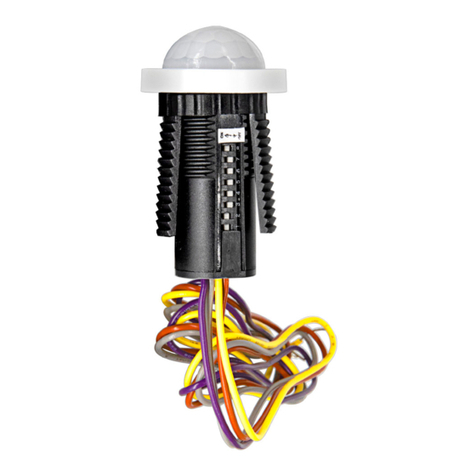
Leviton
Leviton Intellect Solo Sensor ZLS05-ILW installation instructions
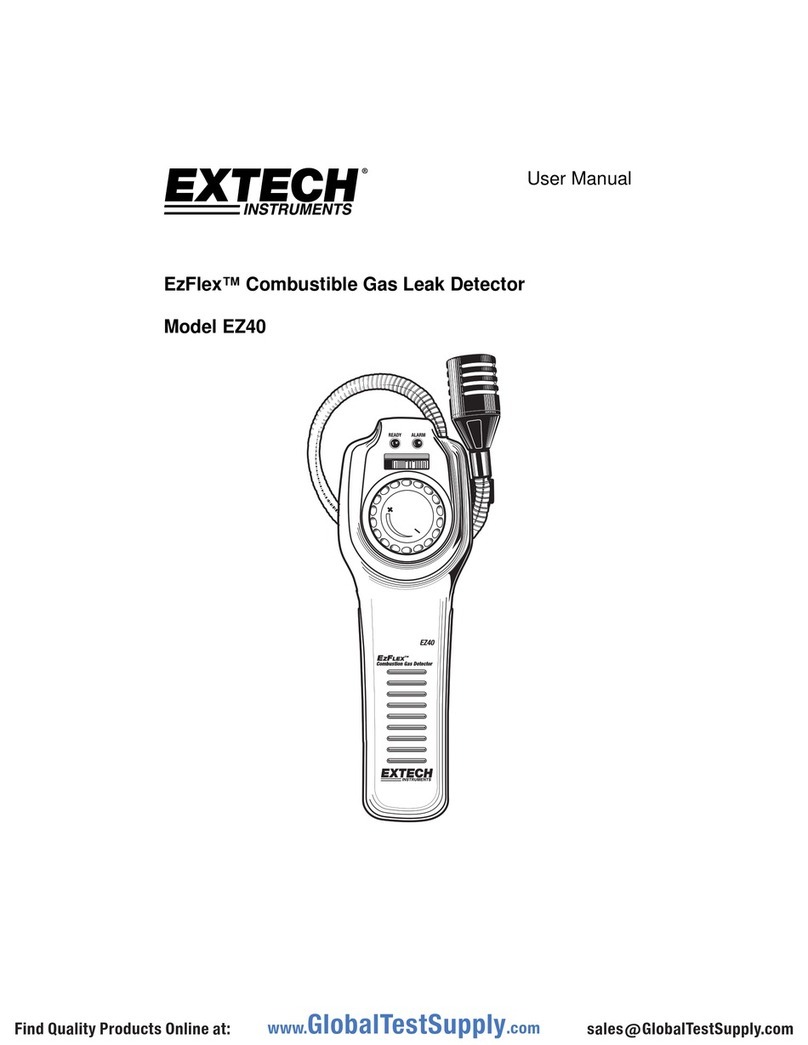
Extech Instruments
Extech Instruments EzFlex EZ40 user manual
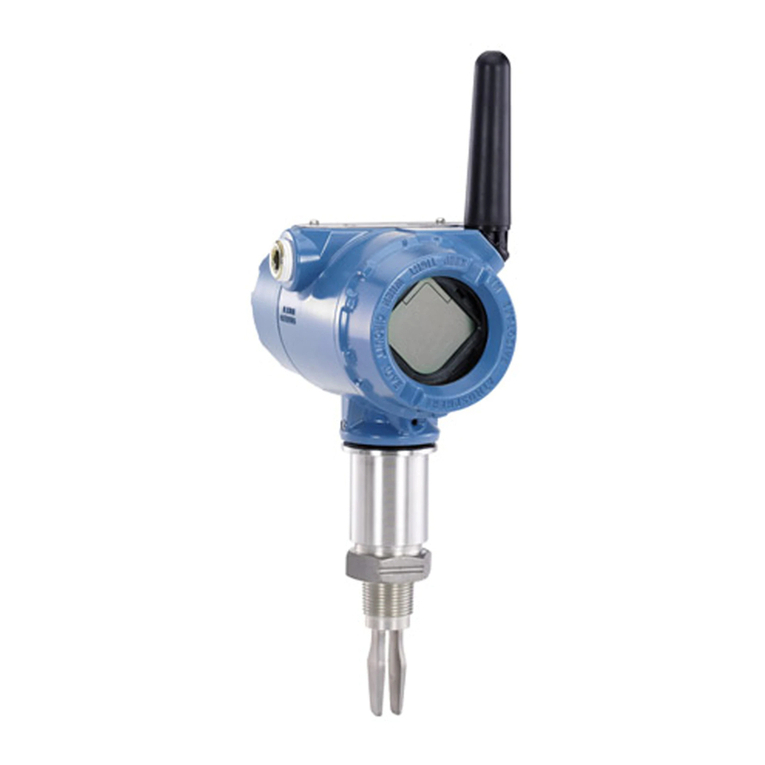
Emerson
Emerson Rosemount 2160 quick start guide
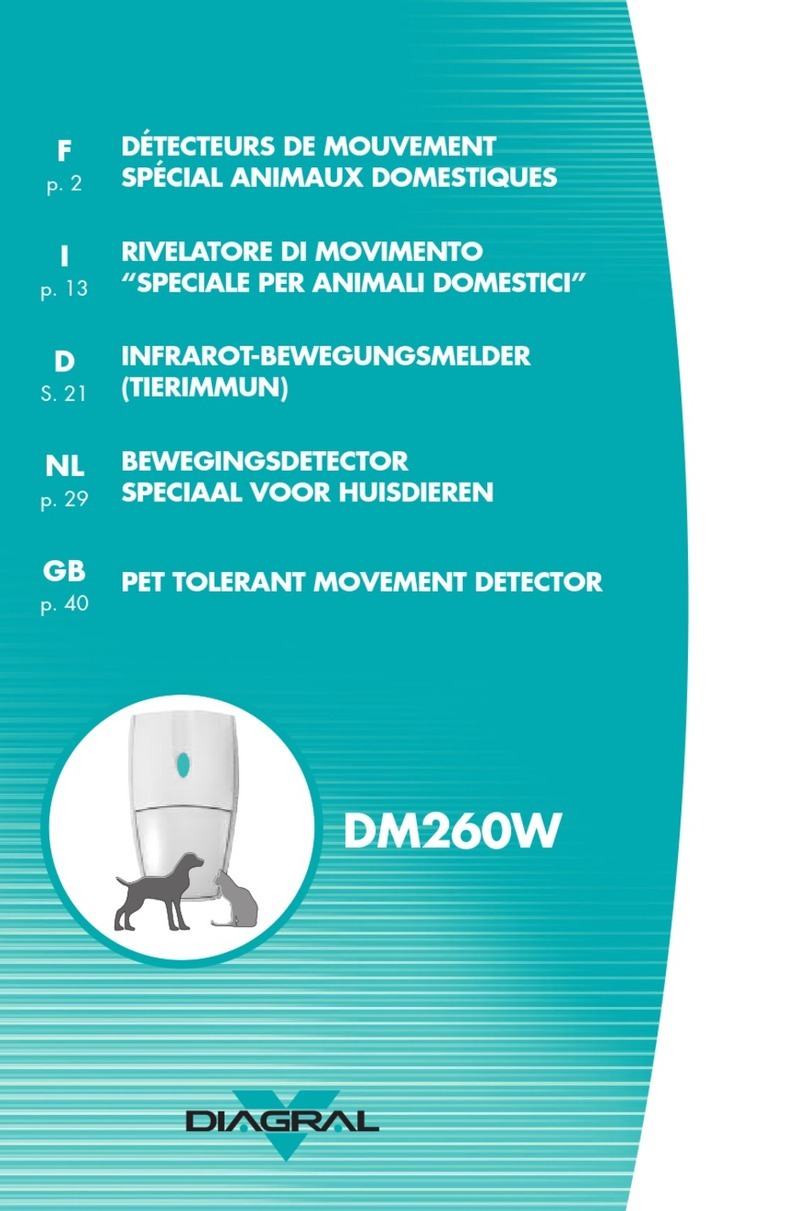
diagral
diagral DM260W instructions
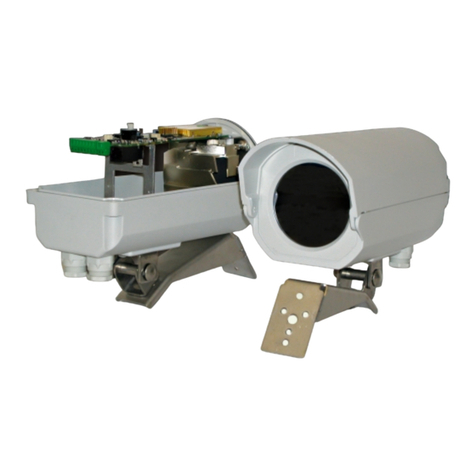
ERNITEC
ERNITEC Eagle PIR-100 installation manual

Bosch
Bosch ZX835 installation instructions
